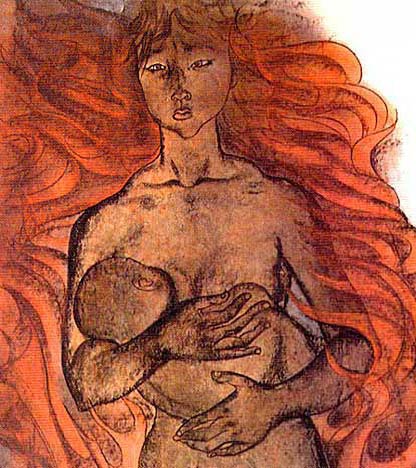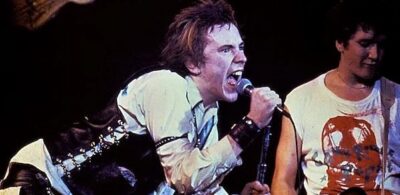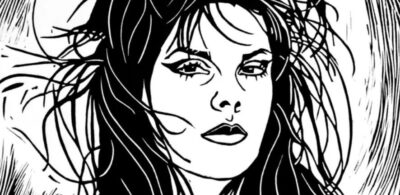Nagasaki Nightmare
“They’re always there high in the skies
Pretty as a picture in the generals’ eyes
They’ve done it once, and they’ll do it again
They’ll shower us all in their deadly rain.”
– Nagasaki Nightmare. Crass.
August 6, 2011 marks the 66th anniversary of the bombing of Hiroshima. On August 6, 1945, the U.S. detonated an Atomic bomb over the city of Hiroshima at 8:15 in the morning. Three days later a second bomb was exploded over the city of Nagasaki at 11:02 in the morning. The Americans called their bombs “Little Boy” (Hiroshima) and “Fat Man” (Nagasaki); the Japanese simply called them Pikadon, meaning “Flash-boom.”

In the early 1990’s I put together on online gallery of art created by Hibakusha (Japanese for “Atom Bomb Survivor”).
The artworks that comprise the gallery were placed in my hands by Japanese peace activists in 1984 through the good graces of now deceased Quaker peace activist Barbara Reynolds. The two illustrations to this article can also be found in the gallery; the artworks are by Iri and Toshi Maruki, who created the Hiroshima panels, a massive mural project with the atomic bombings of Japan as their subject.
After looking at the hibakusha paintings, artworks created by those who survived the first, and hopefully last atomic holocaust, there is little else that can be said about this most unhappy anniversary. It is shameful that governments still posses, or seek to posses, such weapons of mass murder and terror; it is doubly appalling that the people of Japan must now suffer through the Fukishima Daiichi nuclear power plant meltdown disaster. Even as the tragic events continue to unfold in Japan, President Obama presses ahead with his irresponsible plans to construct additional nuclear power plants in the United States. He has set aside $36 billion in loan guarantees for the construction of new nuclear power-plants in the U.S., and has also allocated $185 billion to “maintain and modernize” the U.S. atomic stockpile.
In 1979, Musicians United for Safe Energy (MUSE), organized a series of “No Nukes” concerts in New York. Their concert at Manhattan’s Battery Park City landfill drew over 200,000 people. Musicians Crosby, Stills, and Nash, Bruce Springsteen, Jackson Browne, Bonnie Raitt, Gil Scott-Heron, Tom Petty, and many other notables were involved. No Nukes, a film that documented the concert series, was released in 1980. On August 7, 2011, MUSE will hold a benefit reunion concert of sorts, starring many of the veteran musicians from the ’79 concerts, but also including new performers like Rage Against the Machine, Tom Morello, and Jason Mraz. The concert, to be held at the Shoreline Amphitheater in Mountain View, California, will also be shown in a live video broadcast.

Despite the undeniable contributions made by the aforementioned entertainers, it is the U.K. anarchist punk band Crass that set the standard – at least for this writer – for having created the most profound of all anti-atomic bomb songs, Nagasaki Nightmare.
The song was released just a year after the No Nukes concerts, but the piece of music was worlds apart in terms of aesthetics and attitude. In fact to this day most listeners will probably regard Crass’ opus as nothing more than irritating noise, however, as an avant-garde arrangement I regard it as perfect in every respect.
Having been a participant in the early L.A. punk movement, I still contend that punk from the late 1970s and early 1980s was on equal par to the best protest music of the 1960s, or any other period for that matter, and Crass’ doleful ode to the horrors of nuclear war and the bloodlust of national leaders is a perfect example of the punk aesthetic.
Crass released Nagasaki Nightmare as their second 45 single in August of 1980, and despite receiving absolutely no radio airplay, the record quickly reached the number one spot on the U.K. indie singles chart. The record was entirely self-produced and distributed by the band, and packaged in a marvelous wraparound sleeve with artwork by Gee Vaucher. The single also included a small silk-screen cloth patch printed with the Japanese kanji for “anti-war”, it is a patch I proudly wore pinned to my leather jacket for many years – I still have it in my possession.
Nagasaki Nightmare begins with the gentle sound of a traditional Japanese shakuhachi flute made of bamboo. The composition ends with the sound of a Japanese Buddhist Temple Gong being gently rung over and over; in the context of the overall piece of music it is the saddest sound imaginable, a bidding of farewell to tens of thousands who perished in atomic fire. What takes place between the opening and closing of the arrangement almost defies description; layers of spoken word and frenzied, panic-stricken vocals – a melodic high range female voice spouting poetic lyrics juxtaposed against a raspy male voice barking the refrain “Nagasaki Nightmare”; a relentless primitive base guitar line reminiscent of the patter of falling rain – only here I speak of radioactive black rain.
Midpoint in the song everything falls apart, the vocals become incoherent babbling; the utterances of a deranged young woman wandering aimlessly in the atomic wasteland, the frenetic guitar riffs and crashing drums evoking the flash of a nuclear explosion. Somehow the band managed to capture all of the terror of atomic warfare, as much as anyone could in a piece of music. To my knowledge no one has done this before or since – no one has even tried.
You can hear Nagasaki Nightmare on YouTube, where the lyrics can also be read. The song is also presented on the group’s “Best Before” compilation album, obtainable on iTunes.




